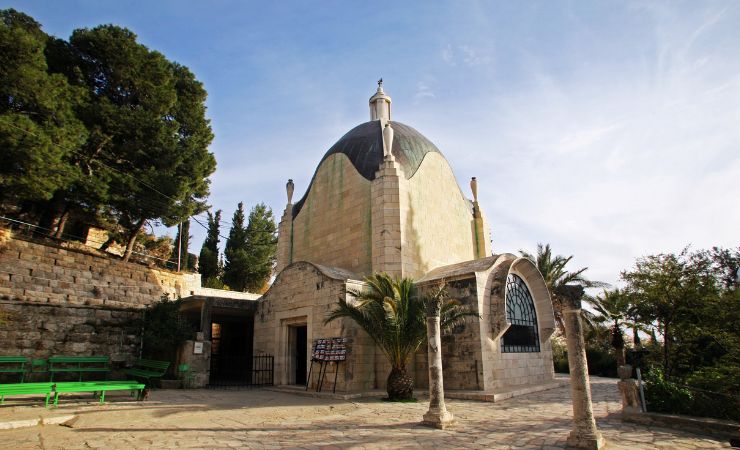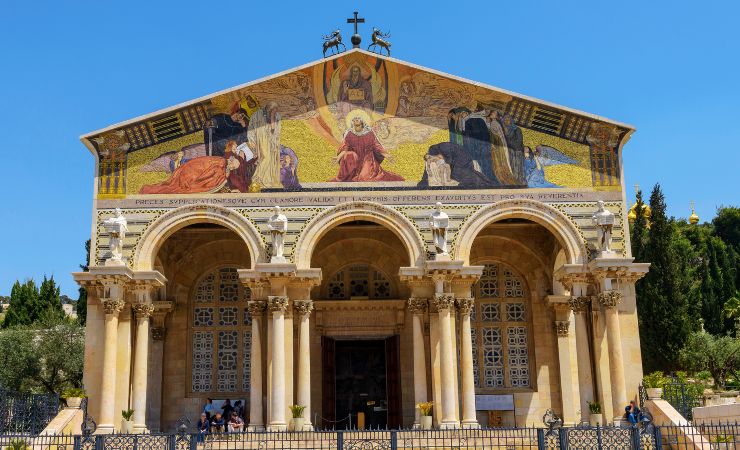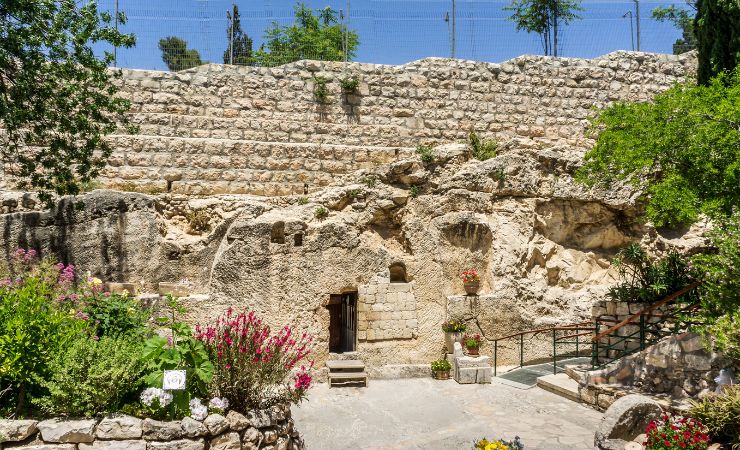Capernaum: The Primary Base for Jesus' Early Ministry
Originally published: August 2024 | Last updated: May 2025
Capernaum, a name that resonates deeply with biblical scholars and Christians alike. Capernaum is frequently mentioned in the New Testament, particularly in the Gospels. It served as the primary base for Jesus’ early ministry. Many of his teachings and miracles, as recorded in the Gospels, took place in this town. The name “Capernaum” is derived from the Hebrew name “Kfar Nahum,” which translates to “Nahum’s Village.” However, it’s worth noting that the town’s association with the prophet Nahum is not definitively established, and the origin of its name remains a topic of discussion among scholars.
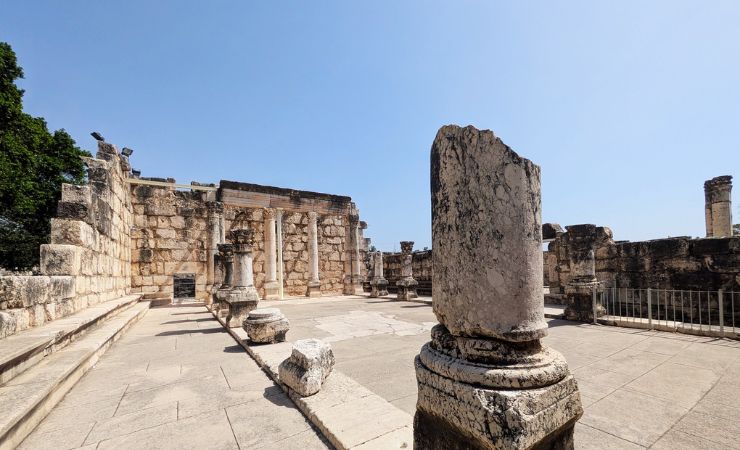
Location
Capernaum is situated on the northwestern shore of the Sea of Galilee. It is the final stop of the 4-day Jesus Trail pilgrimage route.
Biblical context
Capernaum is frequently mentioned in the New Testament. It was here that Jesus chose to base much of his ministry after leaving Nazareth. The town is cited in all four gospels, where it was reported to be the hometown of the tax collector Matthew. It was also located not far from Bethsaida, the hometown of apostles Simon Peter, Andrew, James, and John.
Jesus performed numerous miracles in Capernaum. He healed the centurion’s servant, Simon Peter’s mother-in-law, and a paralytic man who was lowered through a roof to reach him. The ancient synagogue of Capernaum is particularly significant; it is believed that Jesus taught and performed miracles there. Despite witnessing many of Jesus’ miracles, the town was later rebuked by Jesus for its lack of faith source.
Jesus’ Base of Ministry
After being driven from Nazareth by religious officials, Jesus chose Capernaum as His home city (Luke 4:16, 28–30). This made Capernaum a central location for many of His teachings and miracles.
Calling of the Disciples
In Capernaum, Jesus called Peter and Andrew to follow Him (Matthew 4:18–20). He also called Matthew, a tax collector, in this city (Matthew 9:9).
Miracles Performed by Jesus in Capernaum
- Healing the Centurion’s Son: In the bustling streets, a Roman centurion, an unlikely believer, approached Jesus. His servant lay paralyzed at home. Yet, with unwavering faith, he believed a mere word from Jesus could heal from a distance. Jesus, moved by such belief, declared, “Lord, I do not deserve to have you come under my roof. But just say the word, and my servant will be healed.” (Matthew 8:8)
- Healing of Simon Peter’s Mother-in-law: As the sun set, casting a golden hue, Jesus entered Peter’s humble abode. There, Peter’s mother-in-law lay feverish. With a gentle touch, the fever dissipated, and she rose, her strength renewed. “He touched her hand, and the fever left her, and she got up and began to serve him.” (Matthew 8:15)
- Healing the Paralytic: In a home packed with eager listeners, a paralyzed man was lowered through the roof, his friends’ determination evident. Jesus, recognizing this profound faith, declared forgiveness before granting physical healing. “When Jesus saw their faith, he said to the paralyzed man, ‘Son, your sins are forgiven.'” (Mark 2:5)
- Casting Out an Unclean Spirit: Amid the sacred silence of a Capernaum synagogue, a man possessed cried out. With authority and compassion, Jesus commanded the spirit’s departure, restoring peace. “‘Be quiet!’ said Jesus sternly. ‘Come out of him!’ The impure spirit shook the man violently and came out of him with a shriek.” (Mark 1:25-26)
- Healing the Nobleman’s Son: From Galilee, a distraught official sought Jesus for his dying son in Capernaum. With a promise, Jesus sent him on his way. The joyous news of recovery met the official, reinforcing his newfound faith. “Then the father realized that this was the exact time at which Jesus had said to him, ‘Your son will live.’ So he and his whole household believed.” (John 4:53)
- Walking on Water: Under a starlit sky, after feeding thousands, Jesus treaded upon the Sea of Galilee’s waves toward his deciples boat. His disciples, initially struck with fear, found solace in his reassuring presence. “But he said to them, ‘It is I; don’t be afraid.’ Then they were willing to take him into the boat, and immediately the boat reached the shore where they were heading.” (John 6:20-21)
- Raising Jairus’s Daughter and Healing a Woman: Jairus, a synagogue leader, approached Jesus with a heavy heart; his daughter lay on the brink of death. As they hurried, a woman, plagued by years of bleeding, touched Jesus’ cloak, finding instant healing. Yet, news of Jairus’s daughter’s death reached them. Undeterred, Jesus entered the home, took the girl’s hand, and breathed life back into her. “Daughter, your faith has healed you. Go in peace and be freed from your suffering.” (Mark 5:34) for the woman, and “Little girl, I say to you, get up!” (Mark 5:41) for Jairus’s daughter.
Teachings at the Synagogue
Jesus often taught in the synagogue of Capernaum. One of His notable teachings here was about the bread of life (John 6:35-59).
Denunciation of Capernaum
Despite witnessing numerous miracles, the people of Capernaum largely did not repent and believe in Jesus. This led Jesus to rebuke the city, saying, “And you, Capernaum, will you be lifted to the heavens? No, you will go down to Hades” (Luke 10:13–15).
The Miraculous Catch of Fish
One of the first miracles that Jesus performed in Capernaum was allowing the future disciples to catch a miraculous amount of fish. He asked Simon (later renamed Peter) to take Him out in a boat. From there, He taught the crowds. After teaching, He instructed Simon to sail into deeper waters and let down his net, resulting in a miraculous catch.
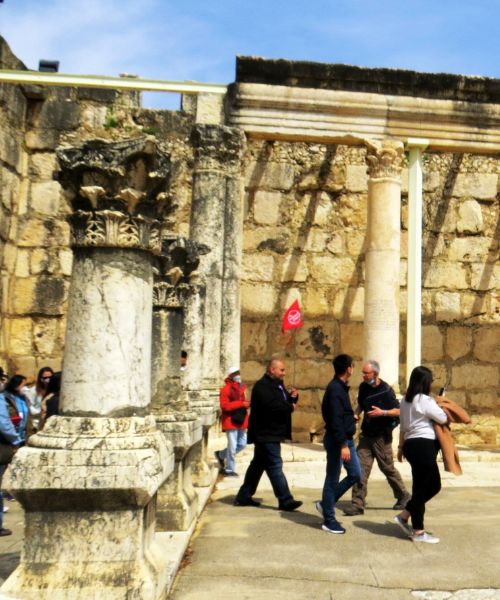
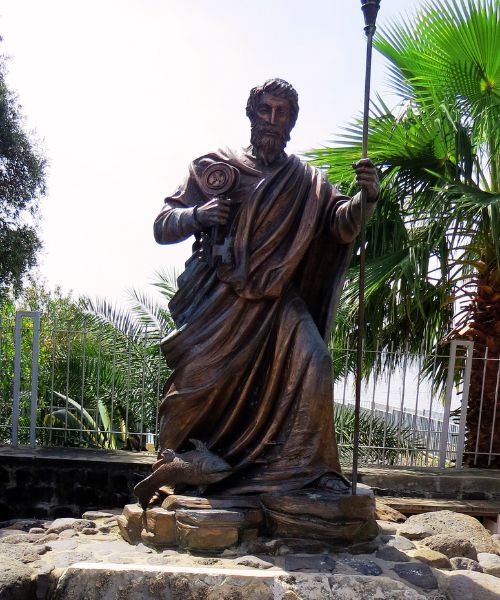
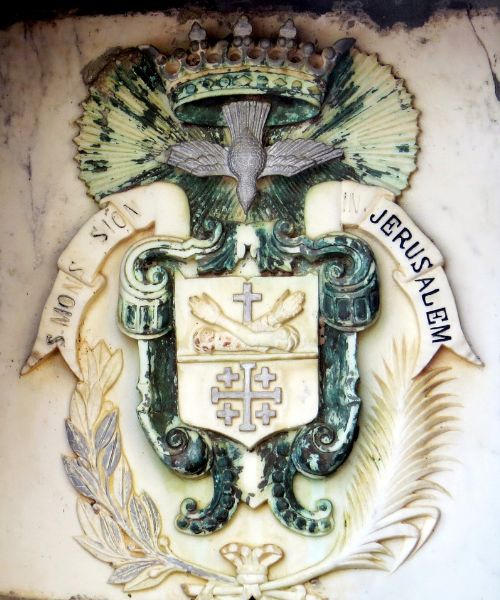
The Archeology of Capernaum
Archaeological excavations in Capernaum have unveiled two ancient synagogues built one over the other. A house, which was later transformed into a church by the Byzantines, is believed to have been Saint Peter’s home. The ruins of these structures serve as a testament to the town’s rich history and its biblical significance source.
The Synagogue: One of the most significant structures unearthed in Capernaum is the ancient synagogue. This grand white limestone building stands out amidst the town’s basalt architecture. It is believed to date back to the 4th or 5th century AD. Stones with decorative carvings and symbolic elements, such as depictions of the Ark of the Covenant, are also on display near the structure. Beneath the later limestone synagogue are traces of an earlier building made from local basalt stone, including a cobbled pavement dated to the 1st century CE. This earlier synagogue is likely the one that existed during Jesus’s time and where, according to the New Testament, he taught. Although most of it is now covered with cement, parts of its entrance are still visible, along with basalt columns placed in the surrounding area to mark the original structure.
House of Saint Peter: A modest dwelling in Capernaum has garnered much attention due to its potential religious significance. This house, made of simple basalt stones, underwent numerous modifications over the centuries. By the 4th century, it appears to have been transformed into a place of worship. The nature of these modifications, along with ancient inscriptions and graffiti referencing Jesus, have led many to believe that this might have been the home of Saint Peter. In the 5th century, an octagonal church was constructed around what was believed to be Saint Peter’s house. This design was typical for places considered holy, as it allowed pilgrims to walk around the sacred center. The presence of this church further supports the theory that early Christians revered this site as the home of Peter.
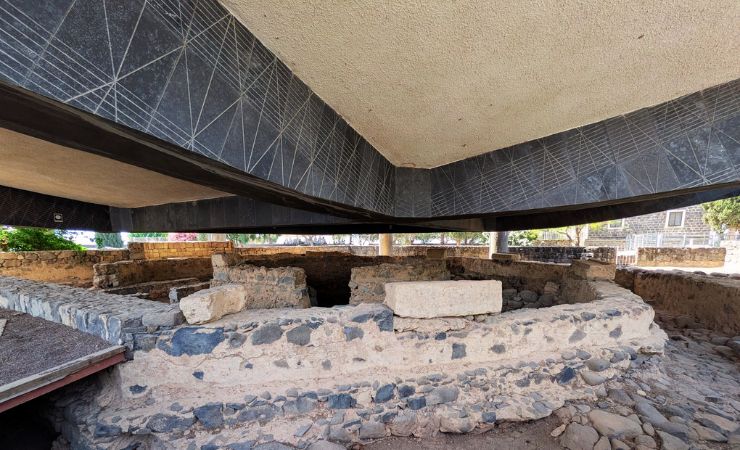
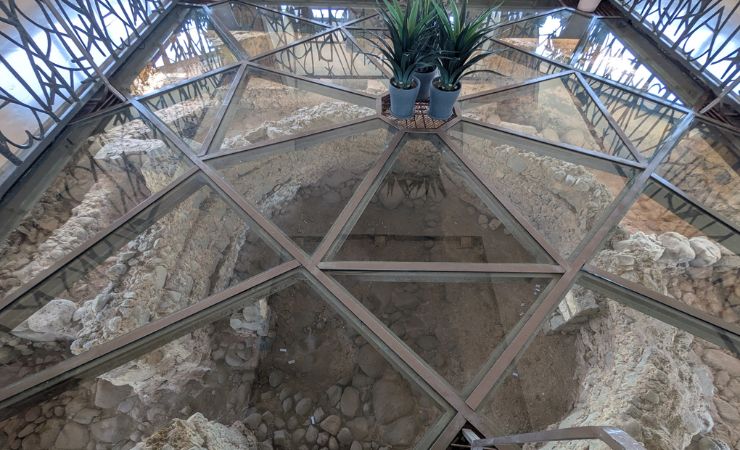
Ruins of the Roman and Byzantine Village: Across the site are remains of a village from the Roman and Byzantine periods. These include houses and narrow streets. Additionally, a well-preserved Roman road runs through Capernaum, a testament to the town’s importance in ancient trade routes. This road would have seen countless travelers, traders, and perhaps even figures from the Bible.
Ritual Baths and Olive Press: Excavations in Capernaum have also revealed several ritual baths, indicating the presence of a significant Jewish community. Additionally, an ancient olive press was discovered, shedding light on the town’s agricultural practices.
Fishermen’s Tools: Given Capernaum’s location by the Sea of Galilee, it’s no surprise that evidence of its fishing industry has been uncovered. Archaeologists have found weights for fishing nets, hooks in the area. A boat from the 1st century AD nearby (known as the “Jesus Boat”).
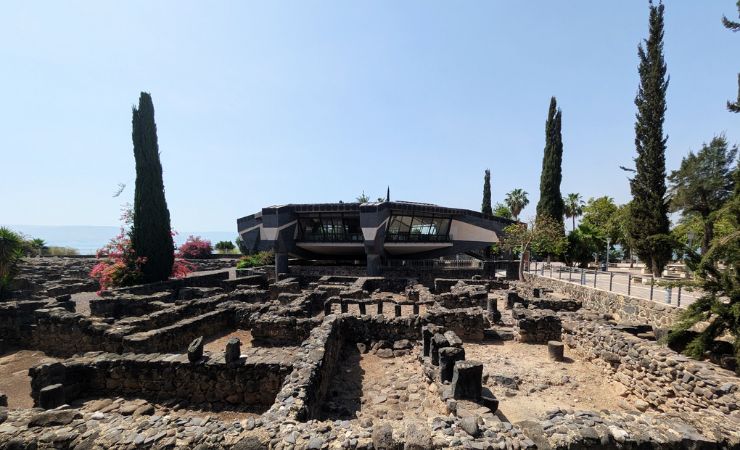
The Modern Franciscan Church (Memorial Church)
This modern church, completed in 1990, stands above the site traditionally identified as the house of St. Peter. It is built on eight concrete pillars to allow visitors to view the ancient remains beneath. A glass floor in the center of the church makes it possible to look down into the archaeological site below.
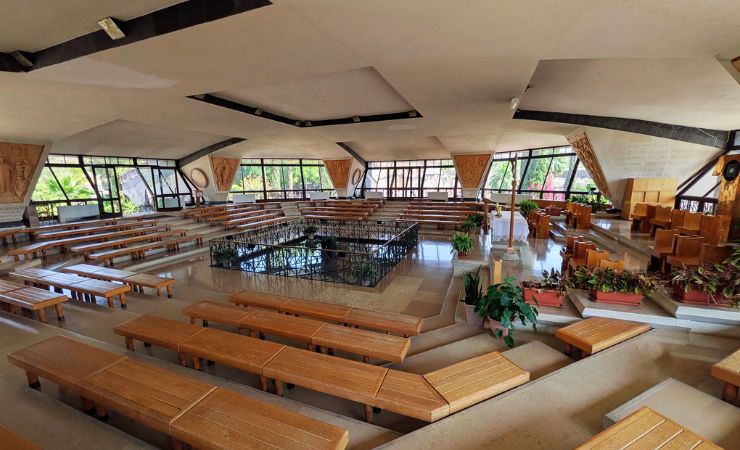
Additional Information
Capernaum – Wikipedia
- 2nd Century BC (Hasmonean Period): Capernaum is established as a fishing village on the northern shore of the Sea of Galilee. Several other fishing villages also emerge around the lake during this time.
- Early Roman Period (1st Century AD): Capernaum grows larger. A synagogue is built in the center of the village.
- During Jesus’ Early Ministry (1st Century AD): Capernaum serves as Jesus’ primary base. He resides in the town, teaches in the synagogue, calls his first disciples from their fishing activities, and performs numerous miracles.
- During Jesus’ Ministry (1st Century AD): Jesus teaches about the bread of life in the Capernaum synagogue. During Jesus’ Ministry , Jesus denounces Capernaum due to the lack of repentance and belief among its inhabitants despite witnessing his miracles.
- Mid-1st Century AD: One specific house in Capernaum, believed to be the home of Saint Peter, begins to be venerated as a religious gathering place. Its main room is plastered, and domestic ceramics are replaced with lamps and storage jars.
- Latter Half of the 1st Century AD: The main room of the house believed to be Peter’s is reworked and plastered, suggesting it was used as a communal gathering place or house church (domus ecclesiae).
- Through the Early 4th Century: The group of private houses around the courtyard known as the sacra insula (which includes the house believed to be Peter’s) remains in use.
- Early to Mid-4th Century AD: The first-century synagogue in Capernaum is replaced by the grand white-stone synagogue.
- 4th Century AD: The sacra insula (including Peter’s house) is transformed. A thick-walled enclosure is built around the entire compound. The specific room believed to be Peter’s house is altered and expanded with a central archway, reinforced walls, pavement, and plastering.
- 5th Century AD: An octagon church is built over the location of St Peter’s house. The village of Capernaum reaches its peak size of about 60 Dunams (6 Hectares) with a population of approximately 1,500.
- Late 19th Century: Exploration of biblical places in the Holy Land begins, often driven by a desire to find demonstrable evidence of biblical accuracy. Charles Wilson and Charles Warren arrive in Jerusalem with support from the Palestine Exploration Fund, aiming to remove difficulties in understanding the sacred text through archaeology.
- Early 20th Century onwards: Archaeological excavations are conducted at Capernaum, revealing the ruins of the synagogue, houses (including the “House of Peter”), and other structures.
- 1990: A modern memorial structure is built over the “House of Peter” site in Capernaum.
Nearby Sites
- Bethsaida: Another city in the Evangelical Triangle, Bethsaida is believed to be the birthplace of several apostles and a site of Jesus’ miracles.
- Mount of Beatitudes: This serene location is traditionally believed to be where Jesus delivered the Sermon on the Mount. The Church of Beatitudes is located on the mount.
- Tabgha: Known for the Church of the Multiplication, Tabgha is believed to be the site of Jesus’ miracle of feeding the 5,000.
- The Jesus Boat: The “Jesus Boat” is a 1st-century AD fishing boat discovered in the Sea of Galilee, discovered and preserved in the 1980s.
- Magdala: Magdala is an ancient Jewish town renowned as the home of Mary Magdalene. Its archaeological sites, including a well-preserved 1st-century synagogue.

